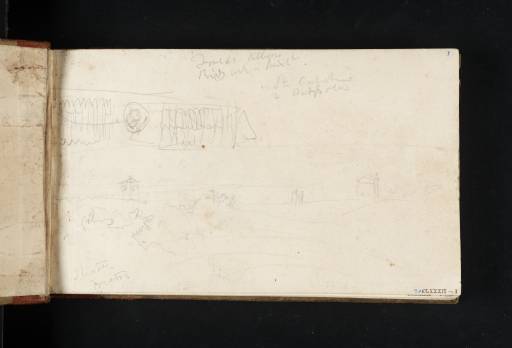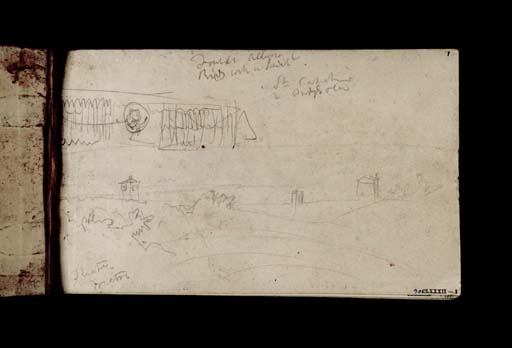Joseph Mallord William Turner View of Albano from the Amphitheatre; and Sketch of a Decorated Tomb 1819
Image 1 of 2
Joseph Mallord William Turner,
View of Albano from the Amphitheatre; and Sketch of a Decorated Tomb
1819
Joseph Mallord William Turner 1775–1851
Folio 1 Recto:
View of Albano from the Amphitheatre; and Sketch of a Decorated Tomb 1819
D15296
Turner Bequest CLXXXII 1
Turner Bequest CLXXXII 1
Pencil on white wove paper, 113 x 189 mm
Inscribed by the artist in pencil ‘[?Tomb] at Albano’ and ‘Ruins with a [?Jewel]’ top centre and ‘St Capuchins | 2 Palazzola’ underneath and ‘Theatre | Teatro’ bottom left and ‘Sea’ within centre of sketch
Inscribed by John Ruskin in blue ink ‘1’ top right and ‘301’ bottom right
Stamped in black ‘CLXXXII 1’ bottom right
Inscribed by John Ruskin in blue ink ‘1’ top right and ‘301’ bottom right
Stamped in black ‘CLXXXII 1’ bottom right
Accepted by the nation as part of the Turner Bequest 1856
References
1909
A.J. Finberg, A Complete Inventory of the Drawings of the Turner Bequest, London 1909, vol.I, p.536, as ‘Sepulchral remains in the Campagna; also “Tombs at Albano” ’.
1984
Cecilia Powell, ‘Turner on Classic Ground: His Visits to Central and Southern Italy and Related Paintings and Drawings’, unpublished Ph.D thesis, Courtauld Institute of Art, University of London 1984, p.194 note 102.
1987
Cecilia Powell, Turner in the South: Rome, Naples, Florence, New Haven and London 1987, p.[88] note 78.
The inscription in the bottom left-hand corner of the page, and the elliptical sweeping pencil strokes in the foreground reveal that the location for this view is the remains of the Roman amphitheatre at Albano.1 Along the horizon in the background is the Mediterranean Sea which lies approximately thirteen miles south-west of the town. Another inscription refers to two nearby locations, the monastery at Palazzola, near the shores of the lake, and the church and convent of the Capuchins in Albano, represented by the building and wall on the far right. In the middle distance on the left is the top of the tower of the Church of San Paolo, the subject of a drawing on the following page, see folio 1 verso (D15297).
The top of the page contains a rough drawing which appears to be a tomb or sarcophagus decorated with striations and a roundel relief. Albano, is rich in remains from the ancient Latium city of Alba Longa, and the later Castra Albana, the Roman camp built by Emperor Septimius Severus for his legions.2 The museum and the Archaeological Parks now contain many statues, tombs, sarcophagi and other relics of the camp, and it is possible that Turner came across something of this nature during his passage through or past the town. Alternatively, there is also some similarity to a cliff-face tomb found carved within the rock near the monastic buildings at Palazzola. The monument, decorated with fasces (bundles of rods symbolising power), had already been depicted by Piranesi in his Antichità d’Albano e di Castel Gandolfo 1764,3 and in a coloured aquatint by John Izard Middleton, published in Grecian Remains in Italy: A Description of Cyclopian Walls and of Roman Antiquities, with Topographical and Picturesque Views of Ancient Latium, London 1812.4
Nicola Moorby
May 2008
See photograph in Consociazione Turistica Italiana, Attraverso Italia Illustrazione delle Regioni Italiane: Lazio, vol.11, p.64, fig.93.
How to cite
Nicola Moorby, ‘View of Albano from the Amphitheatre; and Sketch of a Decorated Tomb 1819 by Joseph Mallord William Turner’, catalogue entry, May 2008, in David Blayney Brown (ed.), J.M.W. Turner: Sketchbooks, Drawings and Watercolours, Tate Research Publication, December 2012, https://www


